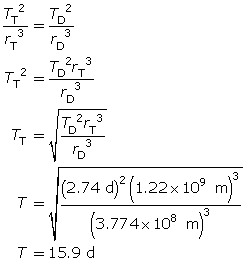Module 5—Circular Motion
Kepler's Third Law
 Module 5: Lesson 3 Assignment
Module 5: Lesson 3 Assignment
Remember to submit the answer to TR 5 to your teacher as part of your Module 5: Lesson 3 Assignment.
 Try This
Try This
TR 5. Use the simulation to investigate Kepler's third law.
- Click the “Rewind” button (
 ).
).
- Click the “Sweep” button (
 ). This will hide the sectors of equal area.
). This will hide the sectors of equal area.
- Click the “Play” button (
 ).
).
- Record the length of the semi-major axis (the mean or average distance between the planet and the Sun or mean orbital radius) from the slider at the bottom of the window. The conventional representation for orbital radius is r.
r = ____________ AU
- Measure the period of the planet (the time to complete one revolution). You may want to click “Replay” (
 ) in order to set the time to zero before making any measurements.
) in order to set the time to zero before making any measurements.
trial 1: Period: ___________ Year
- Modify the eccentricity by adjusting the eccentricity slider. (Note: Do not adjust the semi-major axis.) Again, measure the period of the planet (time for one complete revolution).
trial 2: Period: ___________ Year
- Did changing the orbital eccentricity change the period of the orbit?
Kepler noticed that the eccentricity did not change the period of the orbit. This fact is illustrated in his third law.
Kepler's third law, the law of periods, stated for all planet orbits, the square of the period is proportional to the cube of the semi-major axis (the mean distance from the Sun or mean orbital radius). Expressed as an equation it is
![]()
| Quantity | Symbol | SI Unit | Common Units |
| orbital period | T | s | y or a |
| orbital radius (semi-major axis) | r | m | AU |
| Kepler's constant | K |
 Read
Read
Read about Kepler’s third law beginning on page 271 and continuing to the middle of page 273 of the textbook.
 Module 5: Lesson 3 Assignment
Module 5: Lesson 3 Assignment
Remember to submit the answers to TR 6 and TR 7 to your teacher as part of your Module 5: Lesson 3 Assignment.
 Try This
Try This
TR 6. Calculate Kepler's constant for the solar system using the recorded value for the semi-major axis length and the period from trial 1 or trial 2 in TR 5. (They should be the same.)
K =
TR 7. Verify Kepler's constant by changing the length of the semi-major axis to 1.8 AU and recording the orbital period by clicking “Play” on the simulation and watching it for a complete orbit. Use the “Pause” and “Step” buttons near the end of the full orbit to get the time accurately. Calculate the constant of proportionality again. Circle the units of the proportionality constant.
r = _____________ AU
T = _____________ Year
K = _____________
Comment: In the units of AU and Year, the proportionality constant is numerically equal to 1. Notice that if T is in Years and r in AU, then the equation is as simple as T2 = r3.
 Self-Check
Self-Check
SC 3. Solve question 1 of the “Practice Problems” on page 272 of the textbook.
 Self-Check Answers
Self-Check Answers
SC 3.
Given
r = 5.203 AU
Required
the orbital period of Jupiter (T)
Analysis and Solution
Jupiter orbits the Sun, so the constant K = 1.0 y2/AU3.

Paraphrase
The orbital period of Jupiter is 11.87 years.
 Module 5: Lesson 3 Assignment
Module 5: Lesson 3 Assignment
Remember to submit the answer to TR 8 to your teacher as part of your Module 5: Lesson 3 Assignment.
 Try This
Try This
TR 8. The orbital radius (semi-major axis) of the orbit of Ceres, an asteroid circling the Sun between Mars and Jupiter, is 2.77 AU. Using Kepler's constant for the solar system, calculate the orbital period of Ceres in years.
 Read
Read
The moons circling planets have a different constant, K, because their centres are different. To see how Kepler’s laws apply to moons, read from the middle of page 273 through page 275 of the textbook.
 Self-Check
Self-Check
SC 4. Solve question 1 of “Practice Problems” on page 275 of your textbook.
 Self-Check Answers
Self-Check Answers
SC 4.
Given
rT = 1.22 × 109 m
rD = 3.774 × 108 m
TD = 2.74 d
Required
the orbital period of Titan (TT)
Analysis and Solution
Both planets are orbiting Jupiter, so they will have the same constant for Kepler’s third law. Equate the two ratios for Kepler’s third law, and solve for the period of Titan.

Paraphrase
The orbital period of Titan is 15.9 d.
 Module 5: Lesson 3 Assignment
Module 5: Lesson 3 Assignment
Remember to submit the answer to TR 9 to your teacher as part of your Module 5: Lesson 3 Assignment.
 Try This
Try This
TR 9. Suppose a new moon X was discovered orbiting Jupiter with an orbital period of 42 Earth days. What would be its expected mean orbital radius, using the data for Callisto in “Table 5.6” on page 274 of the physics textbook as a reference?